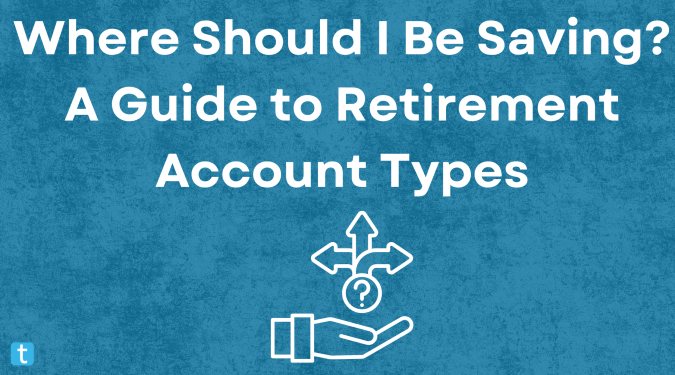So far in our retirement planning series, we’ve covered how to create a vision for your retirement and put numbers to that vision. You now have a target that’s meaningful and specific to you.
The next logical question is: Where should I actually be saving?
Let’s walk through the major account types available to most people – and how to think about using them based on your goals and time horizon.
First: Match Your Account Type to the Time Frame
One of the best rules of thumb I’ve heard comes from my friend and fellow financial planner Cody Garrett, CFP®:
“Give every dollar a job and a use-by date.”
This means the way you save should match when you plan to use the money. Let’s start with retirement accounts.
Retirement Accounts
These are accounts specifically designed to help you build wealth for your future:
1. Employer-Sponsored Plans
Common examples: 401(k), 403(b), 457(b)
You may be offered the choice between pre-tax or Roth contributions:
– Pre-tax contributions lower your taxable income now. You’ll pay tax later when you withdraw the money in retirement.
– Roth contributions are made with after-tax dollars, but qualified withdrawals are tax-free in retirement.
Your employer may also offer a match, which is essentially free money. This is one of the best ways to jumpstart your retirement savings.
2. IRAs (Individual Retirement Arrangements)
Types: Traditional IRA and Roth IRA
IRAs aren’t tied to your job, and they often offer more investment options than an employer plan. They’re excellent for building long-term wealth and can complement your 401(k) or 403(b). As with employer plans, you’ll want to decide between pre-tax (Traditional) or after-tax (Roth) contributions based on your specific tax situation.
3. Health Savings Accounts (HSA)
If you have a high-deductible health plan (HDHP), you may be eligible to contribute to an HSA.
HSAs offer a rare triple tax advantage:
– Contributions are tax-deductible
– Growth is tax-deferred
– Withdrawals are tax-free when used for qualified medical expenses
In retirement, HSAs can even be used for non-medical expenses, with withdrawals taxed like a Traditional IRA. That’s why many call it a “stealth IRA.”
4. Taxable Brokerage Accounts
These accounts don’t offer tax breaks up front, but they do offer flexibility:
– Long-term capital gains rates (often lower than ordinary income rates)
– No penalties for early withdrawals
– Ideal for early retirement (before age 59½)
– Receive a step-up in basis at death, making them efficient for inheritance
A taxable brokerage account can be a powerful tool for both financial flexibility and legacy planning.
So… What’s the Right Order to Save In?
-
Get your employer match.
Contribute enough to capture all of it. Don’t leave free money on the table. -
Max out your Roth IRA or HSA.
If eligible, these accounts offer great tax advantages and flexible investment choices. -
Contribute more to your 401(k)/403(b).
After maxing out your IRA or HSA (or both), go back and increase your contributions here. -
Save in a taxable brokerage account.
This is especially important if you plan to retire before traditional retirement age.
What About Non-Retirement Goals?
While retirement is the focus of this series, many people have short- and intermediate-term goals as well. These require a different savings approach.
College Savings
Many parents rank this as a top priority, even higher than their own retirement. But remember: your child can borrow for college, but you can’t borrow for retirement. Focus on your retirement first, then consider college funding options like:
– 529 plans – Tax-deferred growth and tax-free withdrawals for education; some states offer a tax deduction on contributions.
– Education Savings Accounts (ESAs)
– Taxable brokerage accounts – More flexibility if your child doesn’t attend college
Short-Term Savings
For goals within the next 5 years (like buying a car, taking a trip, or building your emergency fund), keep it simple and safe:
– Use a high-yield savings account or money market account
– Don’t chase high returns. Your priority here is accessibility and stability, not growth
Let's Recap
You’ve made great progress:
– You know your retirement vision
– You know how much it will cost
– Now, you know where to save to make it happen
Key Takeaways:
– Use tax-advantaged retirement accounts first, especially if there’s a match
– Roth IRAs and HSAs can be powerful tools if you’re eligible
– For short- and medium-term goals, keep things liquid and low-risk
In the next post, we’ll explore what to invest in once you’ve chosen the right account types. Remember: An account is just a container. What you put inside it is what grows.
Together Planning is a registered investment advisor. The information presented is for educational purposes only. It should not be considered specific investment advice, does not take into consideration your specific situation, and does not intend to make an offer or solicitation for the sale or purchase of any securities or investment strategies. Together Planning has a reasonable belief that this marketing does not include any false or material misleading information statements or omissions of facts regarding services, investments, or client experiences. Together Planning has a reasonable belief that the content will not cause an untrue or misleading implication regarding the adviser’s services, investments, or client experiences. Be sure to consult with a qualified financial advisor and/or tax professional before implementing any strategy discussed herein.

